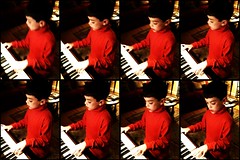[this is a version of a post which first appeared on my blog From the Front of the Choir]
Conductor Kenneth Woods wrote on his blog a while back (As I was just saying) about the problems of having to repeat oneself constantly in rehearsals.

Why, oh why, can’t we just say the thing once and everybody gets it??!! This got me thinking about repetition and its place in rehearsal and learning.
The French word for rehearsal is répétition, which could be translated as ‘repetition’. In order to get good at something we have to do it again and again until we get good at it. So rehearsals are by their very nature repetitions.
The singers or musicians repeat and repeat the same piece over and over again until it becomes second nature. (As an aside: for a community choir which learns songs by ear, where is the dividing line between learning and rehearsing?)
What Kenneth was talking about however was the problem of the conductor giving clear instructions to the choir or orchestra, only to have to repeat the same instruction several times because not everyone got it the first time.
He attributes this to a lack of “in-rehearsal focus” and mentions Georg Solti’s apparent absolute refusal to ever repeat himself in rehearsals. I guess working in the professional world he always had the option of firing anyone who didn’t listen properly!
But I wonder if it’s just lack of focus.
It occurred to me that it also may be an issue of learning styles. It is well-known that different people respond in different ways to being taught. Some need to be shown visually, some need to hear it said and others need to have some kind of tactile input.
There is also an issue of finding the right words or way of expressing something that will click in properly with each individual’s internal concepts. For example, the following are different ways of saying roughly the same thing:
1. “we will go very quiet from here, then at the beginning of the last verse we will gradually get louder until we reach a maximum at the end”
2. “I want pianissimo from bar 12, then a gradual crescendo from bar 18 until we reach forte by the end of the piece”
3. “imagine that you are singing to a baby but don’t want to wake him. Then it’s as if the sun comes out from behind a cloud and the energy of the sound begins to increase from the word ‘moving’ and gets bigger and bigger until by the end we fill the whole house with sound”
Depending on each individual’s personality, experience, and even the kind of day that they’ve had, they may respond to each of the above in different ways.
The first may well get through to the majority of the choir, the second to those few who are musically or mathematically inclined, and the last to those with more visual imaginations.
In a way, we will have repeated ourselves, but it’s more like finding as many different ways of saying the same thing so that we can get through to everyone involved.
We’ve all had the experience of repeating ourselves until we’re blue in the face, only for the person we’re talking to have a light bulb go off in their head when they suddenly get it. It’s just that we’ve eventually found the right way of saying it which has got through to them.
In the meantime, whatever your learning style, please, please, PLEASE pay attention next time I have something important to say!
Chris Rowbury: chrisrowbury.com